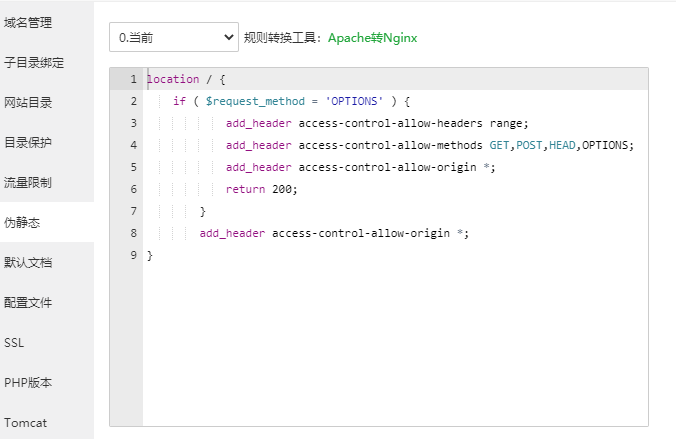系统环境:RHEL5 [ 2.6.18-8.el5xen ]
软件环境:
nginx-0.7.17
lighttpd-1.4.20.tar.gz
pcre-6.6-1.1
pcre-devel-6.6-1.1
php-5.1.6-5.el5
参考下载地址:
http://sysoev.ru/nginx/nginx-0.7.17.tar.gz (最新稳定版为0.6.32)
http://www.lighttpd.net/download/lighttpd-1.4.20.tar.gz
##########################################################################
一、安装支持软件
1、安装lighttpd以提取spawn-fcgi (如果站点不包含php页面,可以不安装spaw-fcgi、PHP)
shell> tar zxvf lighttpd-1.4.20.tar.gz
shell> cd lighttpd-1.4.20/
shell> ./configure && make
shell> cp -p src/spawn-fcgi /usr/sbin/spawn-fcgi
2、安装pcre和php(以下软件)
可使用RHEL5自带的rpm包安装,过程略。
二、安装nginx
shell> tar zxvf nginx-0.7.17.tar.gz
shell> cd nginx-0.7.17/
shell> ./configure –prefix=/opt/nginx –with-http_stub_status_module –with-http_ssl_module
shell> make && make install
shell> ln -sf /opt/nginx/sbin/nginx /usr/sbin/
三、nginx运行控制
1、检查配置文件有无语法错误
shell> nginx -t
2、启动(不带任何参数直接运行即可)
shell> nginx
3、重新加载nginx配置
shell> killall -s HUP nginx #//或者 killall -1 nginx
4、处理完当前请求后退出nginx
shell> killall -s QUIT nginx #//或者 killall -3 nginx
四、nginx配置用例
1、常规配置
shell> vi /opt/nginx/conf/nginx.conf
worker_processes 1; #//工作进程数
events {
use epoll; #//增加该事件提高I/O性能
work_connections 4096;
}
http {
include mime.types;
default_types application/octet-stream;
sendfile on;
tcp_nodelay on
keepalive_timeout 60;
server {
listen 80; #//设置监听端口,注意不要和Apache等其他Web程序冲突
server_name www.linux.org; #//指定使用的主机名
charset utf-8; #//指定站点文件的默认编码
location / {
root html; #//设置网站根目录
index index.html index.html;
}
error_page 500 502 503 504 /50x.html
location = /50x.html {
root html;
}
}
}
2、添加状态监控
shell> vi /opt/nginx/conf/nginx.conf #//增加以下内容
location ~ ^/NginxStatus/ {
stub_status on;
access_log off;
}
shell> killall -1 nginx
#//使用浏览器访问 http://nginx_server_ip/NginxStatus/ 即可看到状态统计页面。(三个数字分别表示:总共处理连接数、成功创建的握手次数、总共处理的请求数)
3、通过FastCGI方式支持PHP语言
1)启动FastCGI服务(用php-cgi做实际处理php页面的程序,用spawn-fcgi是便于同时开启多个php-cgi进程――“-C”选项控制子进程数)
shell>/usr/sbin/spawn-fcgi -a 127.0.0.1 -p 9000 -f /usr/bin/php-cgi -C 10
2)修改/opt/nginx/conf/nginx.conf配置文件,添加以下内容:
location ~ .php$ {
root html;
fastcgi_pass 127.0.0.1:9000;
fastcgi_index index.php;
fastcgi_param SCRIPT_FILENAME $document_root$fastcgi_script_name;
include fastcgi_params;
}
3)重新加载配置
shell> killall -1 nginx
4、虚拟主机设置
修改nginx.conf文件,增加一个server {……}配置即可,每个虚拟主机的参数可以独立配置。
http {
server {
listen 80;
server_name www.vhost1.com;
access_log logs/vhost1.access.log main;
location / {
index index.html;
root /var/www/vhost1; #//第1个虚拟主机的网页根目录
}
}
server {
listen 80;
server_name www.vhost2.com;
access_log logs/vhost2.access.log main;
location / {
index index.html;
root /var/www/vhost2; #//第2个虚拟主机的网页根目录
}
}
}
5、基于反向代理的负载均衡
修改nginx.conf文件,增加upstream配置,指定对应服务器群的IP和权重,并调整server段中的网页根目录配置。使访问nginx服务器的HTTP请求分散到Web群集中的服务器来处理。
http {
upstream my_web_cluster {
server 192.168.2.11:8000 weight=3;
server 192.168.2.12:8000 weight=3;
server 192.168.2.13:8000 weight=3;
server 192.168.2.14:8000 weight=3;
server 192.168.2.15:8000 weight=3;
}
server {
listen 80;
server_name www.domain.com;
location / {
proxy_pass http://my_web_cluster;
proxy_set_header x-real-IP $remote_addr;
}
#//注:其他的location配置段(如关于.php文件的)需注释掉,否则可能影响该类文件的重定向。
}
}















暂无评论内容